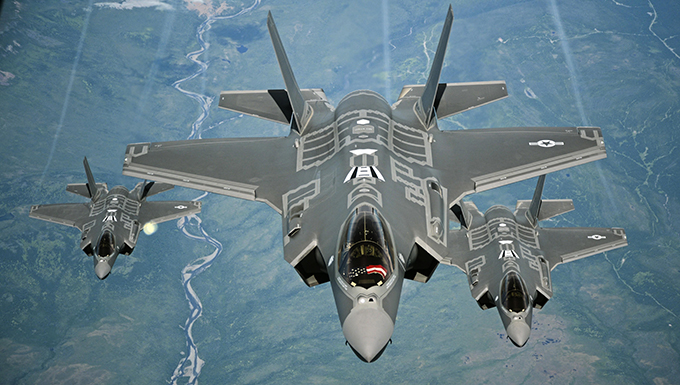F-35A Drops Below $100M; Trump Pentagon Trumpets Jobs
Posted on

F-35As
WASHINGTON: While President Trump has not yet “saved” American taxpayers “billions of dollars” on the F-35 program as his spokesman claimed recently, today’s deal for 90 planes pushes the average cost of an F-35A below $100 million per plane for the first time.
Plane maker Lockheed Martin has promised the F-35A will drop below $85 million by 2019. And the leader of the F-35 Joint Program Office, Lt. Gen. Chris Bogdan, has promised it will hit between $80 million and $85 million for the plane and its engines. The engines are technically a separate program. The latest costs include the engine and assorted other costs.
LRIP 10 – F-35 Costs:
F-35A: $94.6 million
F-35B: $122.8 million
F-35C $121.8 million
The company says in a statement that the increase in production this marks, “enables us to reduce costs by taking advantage of economies of scale and production efficiencies.” For those who haven’t been reading us regularly, the statement also says that the president’s “personal involvement in the F-35 program accelerated the negotiations and sharpened our focus on driving down the price.” However, Bogdan deserves the credit for bringing the price down and for having kept sharp the government’s focus on both price and quality.
White House press spokesman Sean Spicer said Trump had saved taxpayers $455 million. It’s just not true. His tweets and conversations with Lockheed CEO Marillyn Hewson clearly helped push the company to the bargaining table. But, as the top Democrat on the Senate Armed Services Committee told CNBC in an interview, “This is simply taking credit for what’s been in the works for many months.”

Lt. Gen. Christopher Bogdan
“The F-35A unit price in LRIP-10, including aircraft, engine and fee, is roughly seven percent lower than the previous LRIP-9 contract. Over the past two procurement lots (LRIP-9 and 10), the price of the F-35A has dropped 12 percent,” today’s Pentagon statement says.
The most interesting twist with this deal is the stress placed in the Pentagon statement on the economic impact of the program.
“The F-35 provides economic stability to the U.S. and Allied nations by creating jobs, commerce and security, and contributing to the global trade balance. Current low rate production supports more than 1,300 suppliers in 45 states, directly and indirectly employing more than 146,000 people. In addition it employees thousands of military and civil service positions at U.S bases both home and abroad making it the single largest -job generator in the Department of Defense.
“Projections indicate those employment figures could more than double in the next four years following a quadrupling of production from the current 45 a year to more than 160 in 2020. For the decade 2011-2020, the F-35 program will create more jobs than any other Department of Defense initiative. In just this decade alone, the F-35 will infuse $60 billion into the economy. This will turn into hundreds of billions of dollars as the program is schedule to last more than 50 years. Along with the American economic impact, the program will provide billions of more dollars in U.S. exports.”
So, if you don’t want jobs or cash injected into the economy, go ahead and criticize the F-35. Dare ya.
Here’s the breakdown of who’s buying which planes:
44 F-35A for U.S. Air Force
9 F-35B for U.S. Marine Corps
2 F-35C for U.S. Navy
3 F-35B for UK
6 F-35A for Norway
8 F-35A for Australia (presumably the sale occurs only if they don’t send us those refugees…)
2 F-35A for Turkey
4 F-35A for Japan
6 F-35A for Israel
6 F-35A for South Korea
Subscribe to our newsletter
Promotions, new products and sales. Directly to your inbox.
